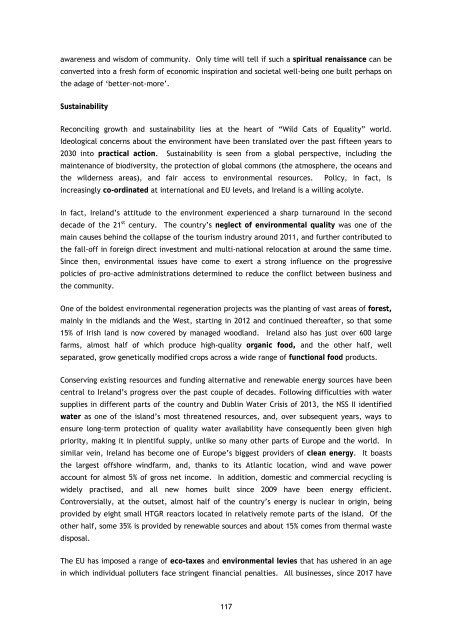TWICE THE SIZE - DIT Update - Dublin Institute of Technology
TWICE THE SIZE - DIT Update - Dublin Institute of Technology
TWICE THE SIZE - DIT Update - Dublin Institute of Technology
You also want an ePaper? Increase the reach of your titles
YUMPU automatically turns print PDFs into web optimized ePapers that Google loves.
awareness and wisdom <strong>of</strong> community. Only time will tell if such a spiritual renaissance can be<br />
converted into a fresh form <strong>of</strong> economic inspiration and societal well-being one built perhaps on<br />
the adage <strong>of</strong> ‘better-not-more’.<br />
Sustainability<br />
Reconciling growth and sustainability lies at the heart <strong>of</strong> “Wild Cats <strong>of</strong> Equality” world.<br />
Ideological concerns about the environment have been translated over the past fifteen years to<br />
2030 into practical action. Sustainability is seen from a global perspective, including the<br />
maintenance <strong>of</strong> biodiversity, the protection <strong>of</strong> global commons (the atmosphere, the oceans and<br />
the wilderness areas), and fair access to environmental resources. Policy, in fact, is<br />
increasingly co-ordinated at international and EU levels, and Ireland is a willing acolyte.<br />
In fact, Ireland’s attitude to the environment experienced a sharp turnaround in the second<br />
decade <strong>of</strong> the 21 st century. The country’s neglect <strong>of</strong> environmental quality was one <strong>of</strong> the<br />
main causes behind the collapse <strong>of</strong> the tourism industry around 2011, and further contributed to<br />
the fall-<strong>of</strong>f in foreign direct investment and multi-national relocation at around the same time.<br />
Since then, environmental issues have come to exert a strong influence on the progressive<br />
policies <strong>of</strong> pro-active administrations determined to reduce the conflict between business and<br />
the community.<br />
One <strong>of</strong> the boldest environmental regeneration projects was the planting <strong>of</strong> vast areas <strong>of</strong> forest,<br />
mainly in the midlands and the West, starting in 2012 and continued thereafter, so that some<br />
15% <strong>of</strong> Irish land is now covered by managed woodland. Ireland also has just over 600 large<br />
farms, almost half <strong>of</strong> which produce high-quality organic food, and the other half, well<br />
separated, grow genetically modified crops across a wide range <strong>of</strong> functional food products.<br />
Conserving existing resources and funding alternative and renewable energy sources have been<br />
central to Ireland’s progress over the past couple <strong>of</strong> decades. Following difficulties with water<br />
supplies in different parts <strong>of</strong> the country and <strong>Dublin</strong> Water Crisis <strong>of</strong> 2013, the NSS II identified<br />
water as one <strong>of</strong> the island’s most threatened resources, and, over subsequent years, ways to<br />
ensure long-term protection <strong>of</strong> quality water availability have consequently been given high<br />
priority, making it in plentiful supply, unlike so many other parts <strong>of</strong> Europe and the world. In<br />
similar vein, Ireland has become one <strong>of</strong> Europe’s biggest providers <strong>of</strong> clean energy. It boasts<br />
the largest <strong>of</strong>fshore windfarm, and, thanks to its Atlantic location, wind and wave power<br />
account for almost 5% <strong>of</strong> gross net income. In addition, domestic and commercial recycling is<br />
widely practised, and all new homes built since 2009 have been energy efficient.<br />
Controversially, at the outset, almost half <strong>of</strong> the country’s energy is nuclear in origin, being<br />
provided by eight small HTGR reactors located in relatively remote parts <strong>of</strong> the island. Of the<br />
other half, some 35% is provided by renewable sources and about 15% comes from thermal waste<br />
disposal.<br />
The EU has imposed a range <strong>of</strong> eco-taxes and environmental levies that has ushered in an age<br />
in which individual polluters face stringent financial penalties. All businesses, since 2017 have<br />
117








